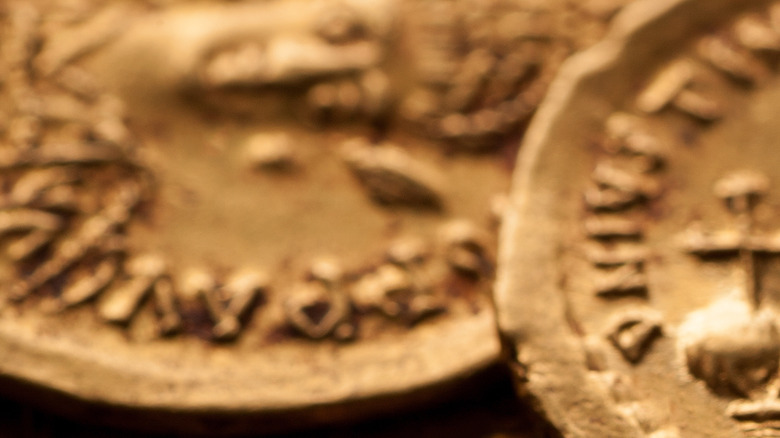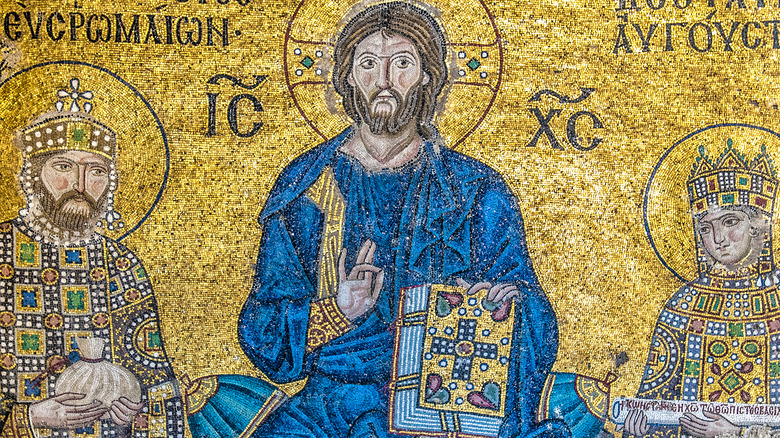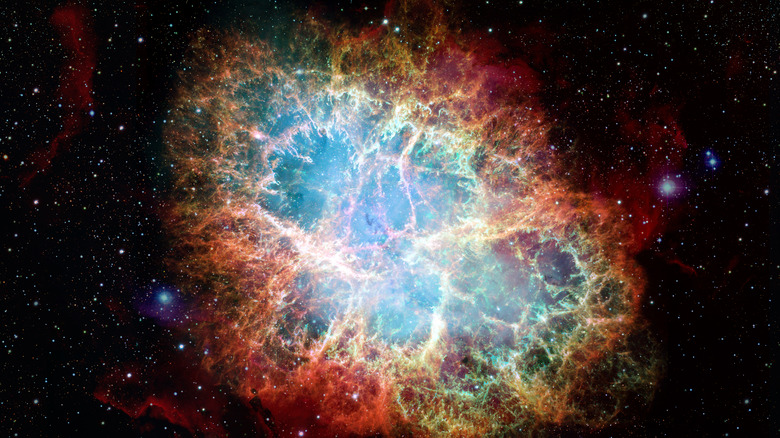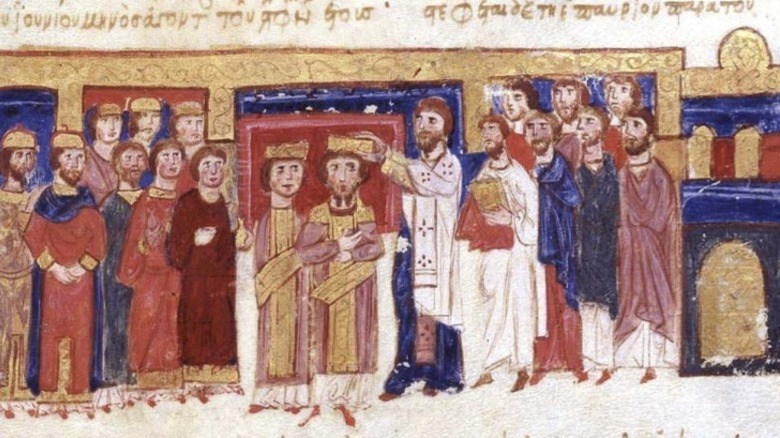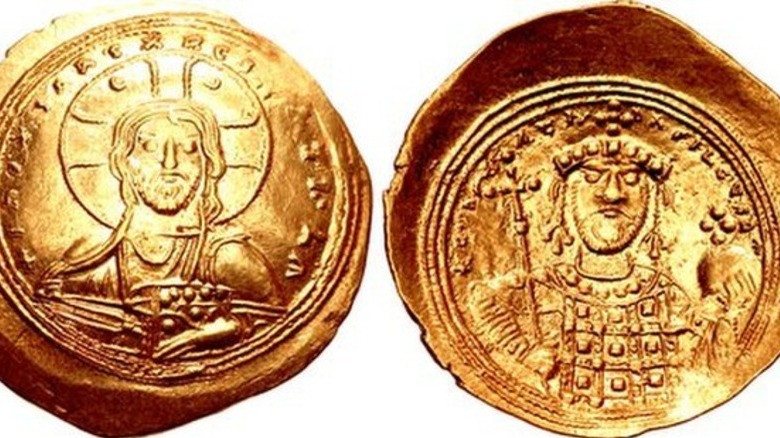These Rare Byzantine Coins May Provide Proof Of A Massive Solar Event
One of life's most profound truths is that we may discover our origins by looking to both the skies and the soil in equal measure. One simply has to look above or below to see traces of our ancestors, how they perceived the world around them, and how their beliefs materialized in their everyday lives. A surprising discovery of rare Byzantine coins in August 2022 by a team of archaeologists from several world-renowned universities advances the notion that the cosmos and regular commerce previously intertwined. This latest in a long line of discoveries not only alters our image of the Byzantines but may also contain the key to solving one of Europe's oldest puzzles (per the European Journal of Science and Theology).
Furthermore, the composition of these coins may indicate a deft act of civil disobedience in the face of enormous governmental pressure to bow to censorship and accept religious dogma over greater cosmic truths.
Hail to the Chief
Constantine IX was the Byzantine Emperor from 1042 until 1055, when the supernova occurred (via Britannica). As was customary in the period, the emperor was in charge of overseeing all trade inside the empire. Most ordinary people in the Byzantine period would have dealt with copper and silver denotations of coinage daily. They did, however, often pay their taxes in gold coins (per World History Encyclopedia).
According to the World History Encyclopedia, artists were often entrusted with creating molds of the emperor's likeness to be etched on coins, and they were regarded as high art. However, like all art at the time, they were subject to censorship. As a result, coins were not only an emblem of the emperor's authority but also a cult of personality that the emperor wanted the ordinary people to engage with in their daily lives, a form of pocket propaganda, if you will.
In 1054, the Christians had come a long way from being fed to lions during the Western Roman Empire — they were now the top dogs. However, irreconciled divisions about indivisible divinities and the nature of God and the Trinity led to the Great Schism that same year. This signified the official split between the Roman Catholic and Orthodox churches, a rift that has never healed.
The 1054 Supernova
In the same year, under Constantine IX's leadership, the world witnessed one of its most brilliant and astounding events, the likes of which we can only imagine. A faraway star 6,300 light years away ran out of nuclear fuel in 1054, collapsed under its own weight, and exploded in a vibrant and furious explosion of energy, a phenomenon known today as a supernova (via Universe Today).
According to The New York Times, this 1054 supernova was one of the brightest ever recorded by humanity in our brief tenure on this planet. This breathtaking display was visible from Earth for over 23 days and hundreds of evenings, and we can only imagine how romantic it must have been. The supernova left behind a cinder in a churning, expanding cloud of gases. We know this because astronomers can now trace this supernova's origins back to the Crab Nebula (pictured above).
Edwin P. Hubble, one of the world's most famous astronomers, was the one who recognized the connection between the Crab Nebula and ancient Chinese literature that mentioned a "guest star" (via The New York Times). Hubble calculated that the creation of this nebula would have occurred some 900 years ago, roughly around the time that this "guest star" initially appeared in ancient Japanese, Arabic, and Native American texts and traditions. According to The New York Times, there is some evidence that Native Americans first etched this event onto stones.
However, one issue remained: Why wasn't it covered in Europe at the time?
Censorship in 1054
According to the research published in the European Journal of Science and Theology, one of the prevailing ideas as to why the supernova was not recorded in the Byzantine Empire was because of newly developed religious dogma. If God was so powerful, what was the explanation for a supernova that the scriptures couldn't explain? As a result, astrology appears to have been suppressed throughout this period since it could have jeopardized the infallibility of the Church and the emperor.
To argue that this vivid exhibition in the heavens was not part of God's plan may be considered heresy, a felony punishable by life imprisonment, exile, or, in extreme cases, death (via The Byzantium Blogger). A continental trend that, regrettably, lasted for generations, as Galileo and Giordano Bruno discovered.
Clues in the Coins
So, how does it relate to the 36 coins discovered last year? Constantine IX is seen on the coins, framed by two stars on his left and right. When you compare the 36 coins in a row, a remarkable sequence appears. According to academics, the star on the right is said to represent Venus (the eastern "morning star"). However, the star on the emperor's left ear gradually diminishes. This closely corresponds to witness descriptions from the time, which describe the supernova gradually diminishing over the course of 23 days until it was only visible at night (via The New York Times).
Furthermore, the split between two stars could artistically mirror the Great Schism, in which two greater powers drift away (via the European Journal of Science and Theology). This has led the researchers to propose the notion that the delicate depiction of the supernova is a covert form of civil disobedience or a subversive artistic comment in response to the state's urge not to depict the supernova in art or literature.
Was the image of the 1054 supernova on these coins the result of a cosmic cover-up? The jury is still out, and more concrete evidence is needed. Regardless, the discovery of these coins still contributes to a greater understanding of the human tapestry from which we are woven. While we cannot be certain, we should continue to look to supernovae for answers to our most profound questions, such as the age of the universe.
